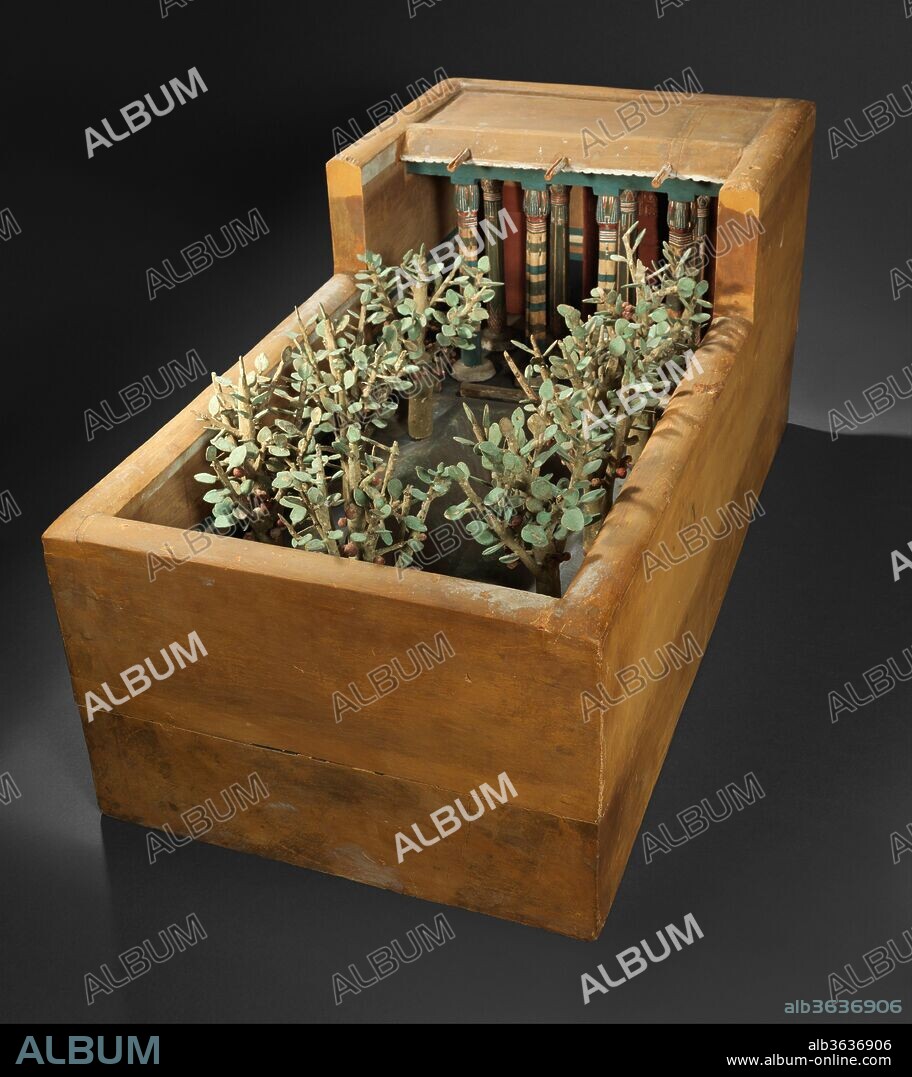alb3636906
Model of a Porch and Garden

|
Añadir a otro lightbox |
|
Añadir a otro lightbox |



¿Ya tienes cuenta? Iniciar sesión
¿No tienes cuenta? Regístrate
Compra esta imagen.
Selecciona el uso:

Título:
Model of a Porch and Garden
Descripción:
Traducción automática: Maqueta de Porche y Jardín. Dimensiones: L. 84,4 cm (33 1/4); ancho 42,5 cm (16 3/4 pulg.); Alto 39,5 cm (15 9/16). Dinastía: Dinastía 12. Reinado: reinado de Amenemhat I, temprano. Fecha: ca. 1981-1975 a.C. Este modelo de jardín y pórtico fue descubierto en una cámara oculta al lado del pasaje que conduce a la tumba excavada en la roca del mayordomo real Meketre, quien comenzó su carrera bajo el rey Nebhepetre Mentuhotep II de la Dinastía 11 y continuó sirviendo a reyes sucesivos. hasta los primeros años de la Dinastía XII. En el centro del jardín hay un estanque rodeado de higueras sicomoros con frutos rojos que crecen en los troncos y ramas. El estanque está revestido de cobre y podría haberse llenado de agua. Frente al jardín se encuentra el porche de una casa. Dos hileras de columnas sostienen el techo formado por troncos de palmera partidos por la mitad. Las columnas traseras tienen capiteles en forma de tallos de papiro unidos, los capiteles de las columnas delanteras imitan haces de loto. Las precipitaciones son raras en el Alto Egipto, pero tal eventualidad está prevista en tres caños salientes. Al fondo del pórtico hay dos puertas y una ventana enrejada. Estos se muestran con más detalle también en el exterior del modelo. El modelo de jardín es, en esencia, un estanque para libaciones (la piscina) con vegetación y arquitectura asociadas. Puede haber vínculos con las llamadas "casas del alma", modelos de casas en arcilla con representaciones de ofrendas en los patios. Todas las habitaciones accesibles de la tumba de Meketre habían sido robadas y saqueadas ya en la Antigüedad; pero a principios de 1920, el excavador del Museo, Herbert Winlock, quería obtener un plano preciso de la disposición de la tumba para su mapa de la necrópolis de la XI Dinastía en Tebas y, por lo tanto, hizo que sus trabajadores limpiaran los escombros acumulados. Fue durante esta operación de limpieza que se descubrió la pequeña cámara oculta, llena de veinticuatro modelos casi perfectamente conservados. Finalmente, la mitad de ellos fueron al Museo Egipcio de El Cairo y la otra mitad llegó al Museo Metropolitano en la sección de hallazgos.
Model of a Porch and Garden. Dimensions: L. 84.4 cm (33 1/4); W. 42.5 cm (16 3/4 in); H. 39.5 cm (15 9/16). Dynasty: Dynasty 12. Reign: reign of Amenemhat I, early. Date: ca. 1981-1975 B.C..
This model of a garden and portico was discovered in a hidden chamber at the side of the passage leading into the rock cut tomb of the royal chief steward Meketre, who began his career under King Nebhepetre Mentuhotep II of Dynasty 11 and continued to serve successive kings into the early years of Dynasty 12.
In the center of the garden is a pond surrounded by sycamore fig trees with red fruit growing from the trunks and branches. The pond is lined with copper and could have been filled with water. Facing the garden is the porch of a house. Two rows of columns support the roof made of palm trunks split into halves. The rear columns have capitals in the form of papyrus stalks bound together, the capitals of the front columns imitate bundles of lotus. Rainfall is rare in Upper Egypt, but such an eventuality is provided for in three projecting spouts. At the back of the portico are two doors and a latticed window. These are depicted in more detail also on the outside of the model. The garden model is in essence a libation basin (the pool) with associated vegetation and architecture. There may be links with the so-called "soul houses," clay models of houses with representations of offerings in the forecourts.
All the accessible rooms in the tomb of Meketre had been robbed and plundered already during Antiquity; but early in 1920 the Museum's excavator, Herbert Winlock, wanted to obtain an accurate floor plan of the tomb's layout for his map of the Eleventh Dynasty necropolis at Thebes and, therefore, had his workmen clean out the accumulated debris. It was during this cleaning operation that the small hidden chamber was discovered, filled with twenty-four almost perfectly preserved models. Eventually, half of these went to the Egyptian Museum, Cairo, and the other half came to the Metropolitan Museum in the partition of finds.
Técnica/material:
Wood, paint, copper
Periodo:
MIDDLE KINGDOM
Museo:
Metropolitan Museum of Art, New York, USA
Crédito:
Album
Autorizaciones:
Tamaño imagen:
3606 x 4048 px | 41.8 MB
Tamaño impresión:
30.5 x 34.3 cm | 12.0 x 13.5 in (300 dpi)


 Pinterest
Pinterest Twitter
Twitter Facebook
Facebook Copiar enlace
Copiar enlace Email
Email
